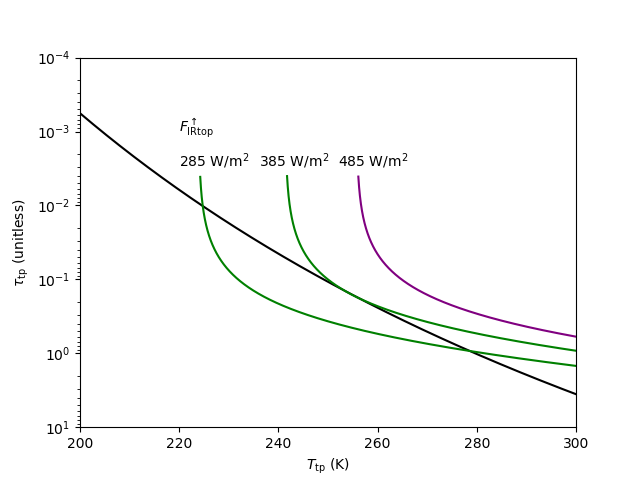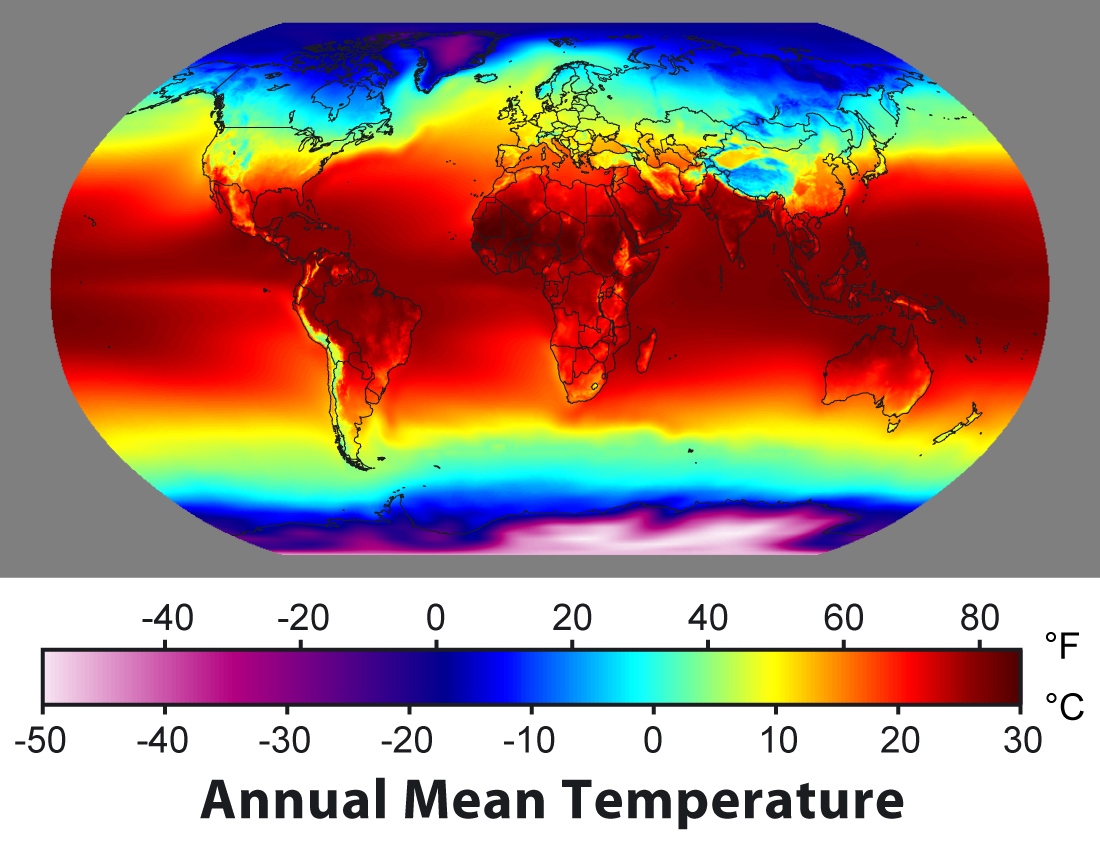|
Komabayashi–Ingersoll Limit
In planetary science, the Komabayashi–Ingersoll limit represents the maximum solar flux a planet can handle without a runaway greenhouse effect setting in.Raymond T. Pierrehumbert. Principles of Planetary Climate. Cambridge University Press. 2010 For planets with temperature-dependent sources of greenhouse gases such as liquid water and optically thin atmospheres the outgoing longwave radiation curve (which indicates how fast energy can be radiated away by the planet) flattens at high temperatures, reaching a horizontal asymptote – the Komabayashi–Ingersoll limit itself. Since the equilibrium temperature is the intersection of this curve and a horizontal line representing solar flux, for fluxes above this point the planet heats up indefinitely. Kasting estimated the limit for Earth to be 320 watts per square meter. The limit is relevant for estimating the inner edge of the circumstellar habitable zone In astronomy and astrobiology, the habitable zone (HZ), or more preci ... [...More Info...] [...Related Items...] OR: [Wikipedia] [Google] [Baidu] |
Planetary Science
Planetary science (or more rarely, planetology) is the scientific study of planets (including Earth), celestial bodies (such as moons, asteroids, comets) and planetary systems (in particular those of the Solar System) and the processes of their formation. It studies objects ranging in size from micrometeoroids to gas giants, with the aim of determining their composition, dynamics, formation, interrelations and history. It is a strongly interdisciplinary field, which originally grew from astronomy and Earth science, and now incorporates many disciplines, including planetary geology, cosmochemistry, atmospheric science, physics, oceanography, hydrology, theoretical planetary science, glaciology, and exoplanetology. Allied disciplines include space physics, when concerned with the effects of the Sun on the bodies of the Solar System, and astrobiology. There are interrelated observational and theoretical branches of planetary science. Observational research ca ... [...More Info...] [...Related Items...] OR: [Wikipedia] [Google] [Baidu] |
Runaway Greenhouse Effect
A runaway greenhouse effect will occur when a planet's atmosphere contains greenhouse gas in an amount sufficient to block thermal radiation from leaving the planet, preventing the planet from cooling and from having liquid water on its surface. A runaway version of the greenhouse effect can be defined by a limit on a planet's outgoing longwave radiation, which is asymptotically reached due to higher surface temperatures evaporating water into the atmosphere, increasing its optical depth. This positive feedback loop means the planet cannot cool down through longwave radiation (via the Stefan–Boltzmann law) and continues to heat up until it can radiate outside of the absorption bands of the water vapour. The runaway greenhouse effect is often formulated with water vapour as the condensable species. The water vapour reaches the stratosphere and escapes into space via hydrodynamic escape, resulting in a desiccated planet. This likely happened in the early history of Venus. In ... [...More Info...] [...Related Items...] OR: [Wikipedia] [Google] [Baidu] |
Greenhouse Gases
Greenhouse gases (GHGs) are the gases in the atmosphere that raise the surface temperature of planets such as the Earth. Unlike other gases, greenhouse gases absorb the radiations that a planet emits, resulting in the greenhouse effect. The Earth is warmed by sunlight, causing its surface to radiate heat, which is then mostly absorbed by greenhouse gases. Without greenhouse gases in the atmosphere, the average temperature of Earth's surface would be about , rather than the present average of .Le Treut, H., R. Somerville, U. Cubasch, Y. Ding, C. Mauritzen, A. Mokssit, T. Peterson and M. Prather, 2007:Chapter 1: Historical Overview of Climate Change. In:Climate Change 2007: The Physical Science Basis. Contribution of Working Group I to the Fourth Assessment Report of the Intergovernmental Panel on Climate Change. olomon, S., D. Qin, M. Manning, Z. Chen, M. Marquis, K.B. Averyt, M. Tignor and H.L. Miller (eds.) Cambridge University Press, Cambridge, United Kingdom and New Yo ... [...More Info...] [...Related Items...] OR: [Wikipedia] [Google] [Baidu] |
Optical Depth
In physics, optical depth or optical thickness is the natural logarithm of the ratio of incident to ''transmitted'' radiant power through a material. Thus, the larger the optical depth, the smaller the amount of transmitted radiant power through the material. Spectral optical depth or spectral optical thickness is the natural logarithm of the ratio of incident to transmitted spectral radiant power through a material. Optical depth is dimensionless, and in particular is not a length, though it is a monotonically increasing function of optical path length, and approaches zero as the path length approaches zero. The use of the term "optical density" for optical depth is discouraged. In chemistry, a closely related quantity called " absorbance" or "decadic absorbance" is used instead of optical depth: the common logarithm of the ratio of incident to transmitted radiant power through a material. It is the optical depth divided by , because of the different logarithm bases used ... [...More Info...] [...Related Items...] OR: [Wikipedia] [Google] [Baidu] |
Outgoing Longwave Radiation
In climate science, longwave radiation (LWR) is electromagnetic radiation, electromagnetic thermal radiation emitted by Earth's surface, atmosphere, and clouds. It is also referred to as terrestrial radiation. This radiation is in the infrared portion of the spectrum, but is distinct from the shortwave radiation, shortwave (SW) near-infrared radiation found in sunlight. Outgoing longwave radiation (OLR) is the longwave radiation emitted to space from the top of Earth's atmosphere. It may also be referred to as ''emitted terrestrial radiation''. Outgoing longwave radiation plays an important role in planetary cooling. Longwave radiation generally spans wavelengths ranging from 3–100 micrometres (μm). A cutoff of 4 μm is sometimes used to differentiate sunlight from longwave radiation. Less than 1% of sunlight has wavelengths greater than 4 μm. Over 99% of outgoing longwave radiation has wavelengths between 4 μm and 100 μm. The Radiative flux, flux of e ... [...More Info...] [...Related Items...] OR: [Wikipedia] [Google] [Baidu] |
Asymptote
In analytic geometry, an asymptote () of a curve is a line such that the distance between the curve and the line approaches zero as one or both of the ''x'' or ''y'' coordinates tends to infinity. In projective geometry and related contexts, an asymptote of a curve is a line which is tangent to the curve at a point at infinity. The word asymptote is derived from the Greek ἀσύμπτωτος (''asumptōtos'') which means "not falling together", from ἀ priv. + σύν "together" + πτωτ-ός "fallen". The term was introduced by Apollonius of Perga in his work on conic sections, but in contrast to its modern meaning, he used it to mean any line that does not intersect the given curve. There are three kinds of asymptotes: ''horizontal'', ''vertical'' and ''oblique''. For curves given by the graph of a function , horizontal asymptotes are horizontal lines that the graph of the function approaches as ''x'' tends to Vertical asymptotes are vertical lines near which the ... [...More Info...] [...Related Items...] OR: [Wikipedia] [Google] [Baidu] |
Circumstellar Habitable Zone
In astronomy and astrobiology, the habitable zone (HZ), or more precisely the circumstellar habitable zone (CHZ), is the range of orbits around a star within which a planetary surface can support liquid water given sufficient atmospheric pressure.J. F. Kasting, D. P. Whitmire, R. T. Reynolds, Icarus 101, 108 (1993). The bounds of the HZ are based on Earth's position in the Solar System and the amount of radiant energy it receives from the Sun. Due to the importance of liquid water to Earth's biosphere, the nature of the HZ and the objects within it may be instrumental in determining the scope and distribution of planets capable of supporting Earth-like extraterrestrial life and intelligence. As such, it is considered by many to be a major factor of planetary habitability, and the most likely place to find extraterrestrial liquid water and biosignatures elsewhere in the universe. The habitable zone is also called the Goldilocks zone, a metaphor, allusion and antonomasia of th ... [...More Info...] [...Related Items...] OR: [Wikipedia] [Google] [Baidu] |
Climatology
Climatology (from Greek , ''klima'', "slope"; and , '' -logia'') or climate science is the scientific study of Earth's climate, typically defined as weather conditions averaged over a period of at least 30 years. Climate concerns the atmospheric condition during an extended to indefinite period of time; weather is the condition of the atmosphere during a relative brief period of time. The main topics of research are the study of climate variability, mechanisms of climate changes and modern climate change. This topic of study is regarded as part of the atmospheric sciences and a subdivision of physical geography, which is one of the Earth sciences. Climatology includes some aspects of oceanography and biogeochemistry. The main methods employed by climatologists are the analysis of observations and modelling of the physical processes that determine climate. Short term weather forecasting can be interpreted in terms of knowledge of longer-term phenomena of climate, for insta ... [...More Info...] [...Related Items...] OR: [Wikipedia] [Google] [Baidu] |
Climate Change Feedbacks
Climate change feedbacks are natural processes that impact how much global temperatures will increase for a given amount of greenhouse gas emissions. Positive feedbacks amplify global warming while negative feedbacks diminish it.IPCC, 2021Annex VII: Glossary[Matthews, J.B.R., V. Möller, R. van Diemen, J.S. Fuglestvedt, V. Masson-Delmotte, C. Méndez, S. Semenov, A. Reisinger (eds.)]. IClimate Change 2021: The Physical Science Basis. Contribution of Working Group I to the Sixth Assessment Report of the Intergovernmental Panel on Climate Change[Masson-Delmotte, V., P. Zhai, A. Pirani, S.L. Connors, C. Péan, S. Berger, N. Caud, Y. Chen, L. Goldfarb, M.I. Gomis, M. Huang, K. Leitzell, E. Lonnoy, J.B.R. Matthews, T.K. Maycock, T. Waterfield, O. Yelekçi, R. Yu, and B. Zhou (eds.)]. Cambridge University Press, Cambridge, United Kingdom and New York, NY, USA, pp. 2215–2256, doi:10.1017/9781009157896.022. Feedbacks influence both the amount of greenhouse gases in the atmosphere and ... [...More Info...] [...Related Items...] OR: [Wikipedia] [Google] [Baidu] |



